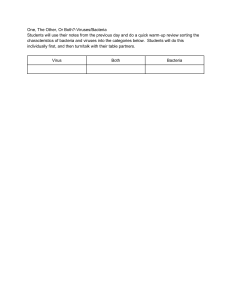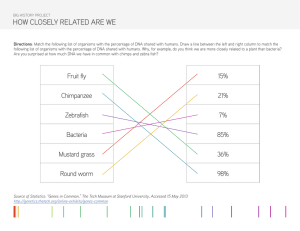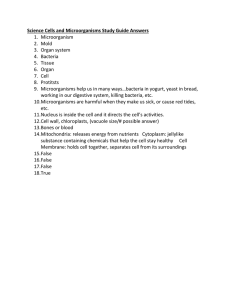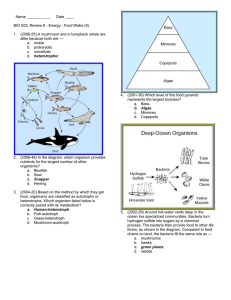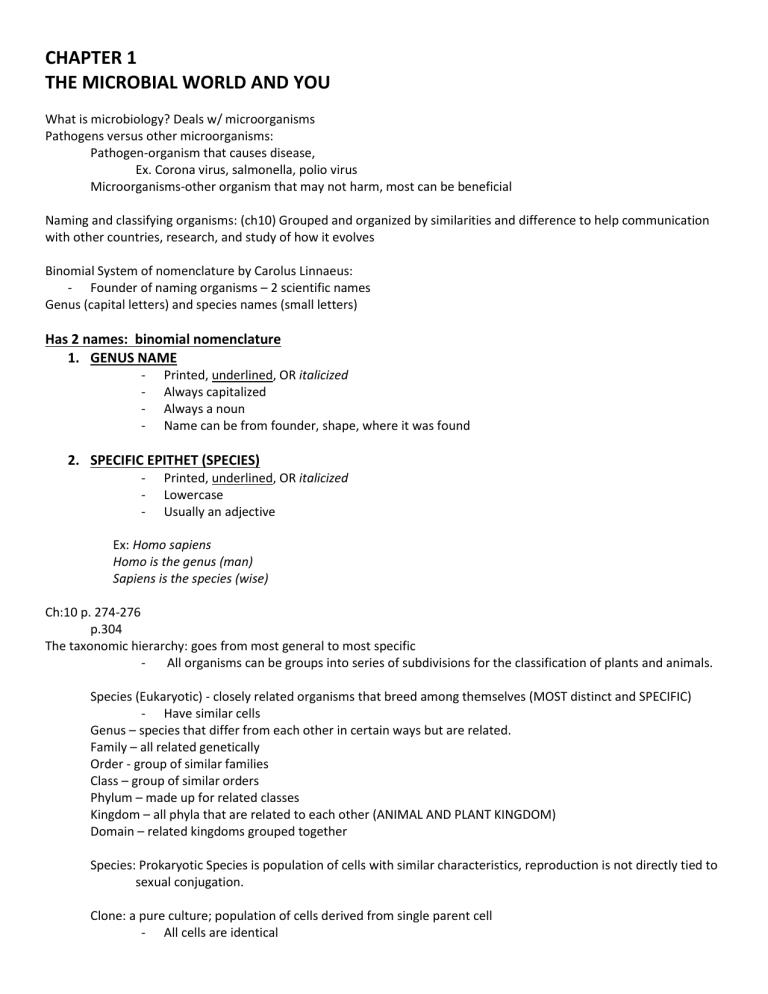
CHAPTER 1 THE MICROBIAL WORLD AND YOU What is microbiology? Deals w/ microorganisms Pathogens versus other microorganisms: Pathogen-organism that causes disease, Ex. Corona virus, salmonella, polio virus Microorganisms-other organism that may not harm, most can be beneficial Naming and classifying organisms: (ch10) Grouped and organized by similarities and difference to help communication with other countries, research, and study of how it evolves Binomial System of nomenclature by Carolus Linnaeus: - Founder of naming organisms – 2 scientific names Genus (capital letters) and species names (small letters) Has 2 names: binomial nomenclature 1. GENUS NAME - Printed, underlined, OR italicized Always capitalized Always a noun Name can be from founder, shape, where it was found 2. SPECIFIC EPITHET (SPECIES) - Printed, underlined, OR italicized Lowercase Usually an adjective Ex: Homo sapiens Homo is the genus (man) Sapiens is the species (wise) Ch:10 p. 274-276 p.304 The taxonomic hierarchy: goes from most general to most specific All organisms can be groups into series of subdivisions for the classification of plants and animals. Species (Eukaryotic) - closely related organisms that breed among themselves (MOST distinct and SPECIFIC) - Have similar cells Genus – species that differ from each other in certain ways but are related. Family – all related genetically Order - group of similar families Class – group of similar orders Phylum – made up for related classes Kingdom – all phyla that are related to each other (ANIMAL AND PLANT KINGDOM) Domain – related kingdoms grouped together Species: Prokaryotic Species is population of cells with similar characteristics, reproduction is not directly tied to sexual conjugation. Clone: a pure culture; population of cells derived from single parent cell - All cells are identical Strain: Clones that are NOT identical are grouped as strains - Some cells are not exactly same but not identical - can be identified by numbers, letter, or names that follow specific epithet - Ex; Covid (sars, 12 different strains); e-coli (some are pathogenic, most are not) - Organism that can interbreed or produce children; are in same population unlike bacteria WHAT IS A VIRUS? - AN OBLIGATE INTRACELLULAR PARASITES NEEDS A LIVING HOST TO REPRODUCE NOT REAL CELLS NO PLASMA MEMBRANE MADE OF DNA OR RNA NEVER BOTH Types of cells ch 10.2 Eukaryotic - cells have true nucleus (DNA of cell is surrounded by nuclear membrane, DNA found in cytoplasm) - all cells are eukaryotic except for bacteria and blue-green algae (prokaryotic) - unicellular - grouped as kingdom Protista Prokaryotic (bacteria) – No true nucleus (or no nuclear membrane) - DNA found in cytoplasm - divided into 2 domains bacteria and Archaea; each is divided into phyla. - Class based on similarities in rRNA nucleotide sequences. - Classes are divided into orders; orders into families; families, into genera; and genera, into species The Three Domains: ch 10.1 p.299 highest level of organization - Have difference in ribosomes and cell wall composition 1. Eukarya 2. Archaea 3. Bacteria Bacteria Domain (prokaryotic) no nuclear membrane - All bacteria are single cell organisms - Has 3 shapes. Rod, sphere, spiral - All bacteria have cell wall except mycoplasma Mycoplasma: only organism that does not have a cell wall (why they thought bacteria was a plant when discovered) Binary fission: how bacteria divides; simple cell divisions 1 cell becomes 2 cells - Some Bacteria moves through flagella Gram positive bacteria: will stain BLUE or PURPLE; more sensitive to anibiotics Gram negative bacteria: will stain RED Gram stains are differential stains: how they isolate a microorganism from someone has an infection because treatment is different Rickettsia: PARASITES obligate intracellular, cannot grow artificially. Needs living host, fever and rash. Bit by insect like flea, tick, other insects. Chlamydia: Need living host. bacteria not virus. o Cannot reproduce on own so cannot be isolated in the lab w/ artificial media o Need living tissue to grow o o Causes venereal disease. STI Cannot see bacteria under microscope. So small. Unlike ghonnereha Cyanobacteria: p307 (blue green algae) o Plant like bacteria o Photosynthetic. Fix CO2 to make sugar and nitrogen from atmosphere to ammonium Archaea Domain: bacteria with different cell wall, has cell wall but different; need special environments to grow (prokaryotic) no nuclear membrane Methanogens: can make methane(gas). Convert CO2 and Hydrogen to methane; Found in Mud, swamps; source of fuel Halophiles: (salt-loving) like salt to grow, 36% cant isolate w/o salt Thermophiles: need heat above 50 degrees centigrade; most bacteria grow at 37 degree; found in hot springs Eukarya Domain: Eukaryotic cells; all have nuclear membrane, p342 and 346 ch12 Kingdom Protista- primitive organism, unicellular organism (protozoa) includes protozoa and algae - Protozoa(p342-346) animal-like, unicellular, includes: amoeba, ciliate, flagellates, other protozoa, Divides w/ basis of movement; flagella moves though pseudopods (force foot) projections from cytoplast which extends and retracts allow amoebas to move (ameboid movement) Amoeba can exist in 2 states: 1. Trophozoite: feeding upon bacteria and small particles nutrients, growing and feeding stage 2. Cyst: when amoeba leave the body protective capsule permitting organism to survives when lacking food, moisture, O2; or when temps are not suitable or when toxic chemicals are present. Has thick protective covering; enables parasitic species to survive outside host. Alive; viable Amoebas: single cell - Move by extending blunt, lobe-like projection of cytoplasm called PSUDOPODS. - Amoebas Histolytica – only pathogenic ameba, found in human intestine. - When amoeba leaves the body ingesting a cyst and becomes a trophozoite and moves all over the body, usually occurs in foreign country when ingesting contaminated food or water Ciliates: shorter than flagella - Small hairs that allow organisms to move all over cells. In paramecium (ciliate) Non-pathogenic organisms moves in unison to propel cell single cell organism Flagellates: moves by flagella, - also, hairlike structure, but longer and fewer than cilia - Euglena – non pathogen; flagellate, free living organism Giardia – pathogenic organism that if cyst is ingested by drinking contaminated water develop severe abdominal pains and diarrhea Other protozoan:(don’t move) malaria organism cause by protozoa plasmodium, through infected female mosquito bite. None motile (doesn’t move) Algae: p337-341 ch 12 Aquatic (live in water) Photosynthetic Single or multicellular organism important in the food chain b/c provides food to microorganisms and animals in water Divided by basis of pigmentation All have Chlorophyll (gives it color) Brown algae: large, found around coast, grow fast, seaweed, (produces algin) kelp, good growth rate, multicellular cell arrangement, stores carbohydrates, brown color, can extract ALGIN (used in food like ice cream or to make rubber tires and hand lotion) can be extracted from cell wall. Red algae: agar (thinkener to make medium in lab) broth, can live in deep oceans, can absorb blue light that penetrates deep ocean, carrageenan (gelatinous) is a red algae species – a thickening ingredient in evaporated milk, ice cream, and pharm agents. Green algae: common, used to make sushi, have cellulose cell walls, has chlorophyll a and b, stores starch, microscopic, unicellular or multicellular, found in plants Diatoms: group of atoms with unique cell walls, have pectin and layer of silica in cell wall used form ajax, stores energy captures through photosynthesis to make oil. Dinoflagellates: plankton, or free floating, 2 flagella, responsible for shellfish poisoning. Causes algal bloom and red tide, when clams and shellfish become poisonus. Lecture 1/27/21 Kingdom Fungi: p325- 327 ALL FUNGI has cell wall, opportunistic (takes advantage) to compromised host, does not have chlorophyll (think mushroom-no green color) MYCOLOGY: study of fungi 2 divisions of kingdom fungi: (yeast and mold) 1. Unicellular Yeasts: yeast is single cell organism, unicellular non-filaments, produce spores uses budding (blimp that pinches off) for sexual and asexual reproduction through mitosis produce spores some cause infection some are beneficial candida-albicans, a pathogen that causes thrush and vaginitis, white spots in throat to compromised host. Makes beer wine and bread Genetic engineering causes yeast to make vaccines Bacteria is prokaryotic yeasts are Eukaryotic cells Asexual reproduction (budding) through mitosis: spores formed by hyphae of 1 organism. When they germinate they create genetically identically organism to parent Sexual reproduction: by meiosis spores result from fusion of nuclei of 2 opposite mating strains of same fungus species. Require 2 different strains and are made less than asexual spores. -have genetic characteristics of both parent strain - has 3 phases - plasmogamy - karyogamy - meiosis Yeast infections: Candida Albican - an over abundance of growth, candid-albicans pathogen, causes thrush and vaginitis, white spots in throat. Benefits: yeast is capable of anaerobic growth allowing fungi to survive and gives access to O2 and perform aerobic respirations to metabolize carbs into CO2 and O2 to make wine. Can also produce ethanol for dough and producing vaccines. 2. Multicellular Molds: p331-334 molds are multicellular ex. bread old, mushroom, where we get penicillin filamented (produce HIFI fuzz) can be septate (has cross walls) or coenocytic or non septate (no cross walls) Hyphae: contain cross walls called septa; grow by elongating at tips; each part can grow, has cross walls. Septate Hyphae: hyphae divide into distinct uninucleate cell like units. Coenocytic: hyphae contain no septa and appear as long, continuous cells with many nuclei, no cross wall (non-septate) Fungal diseases: can be in plants too, mildew or diseases of plants or death to trees. can be superficial (athletes food, ringworm) or deep (affects lungs). Economic effects: beneficial; decomposes dead plant matter and recycling vital elements. Produce enzymes that make fruit juices and other industrial products ex. infection of scalp and nails can produce drugs (recording 3) Kingdom Plantae: (mosses, ferns, conifers, flowering plants): multicellular, uses photosynthesis (CO2 + H2O organic molecules) to get energy Kingdom Animalia (sponges, worms, insects, animals with backbones): multicellular, eats organic matter by mouth to get nutrients and energy. Helminths: causes disease to humans by parasitic worms (part of animal kingdom) - 2 kinds (platy-helminths or flatworms and Nematoda (roundworms) - free living in phyla - multicellular eukaryotic animals - starts as Larval - Dioecious - Separate organisms with separate reproductive organs - monecious worms – having both male and female reproductive organs in one organism - ex: flatworms and round worms 1. Flatworms: platy-helminths, flat dorsal -ex include trematodes (fluke) and cestodes (tapeworm) - cause disturbance in development of animals - Monecious (hermaphroditic; one animal is both male and female) a. Fluke: or trematodes, flat leaf shapes bodies with ventral and oral suckers to hold organism in place, eats through their nonliving outer covering. b. Tapeworm: or cestodes, intestinal parasites, head has suckers. Lacks digestive system, eats by absorbing food through their cuticle. - humans are main host - animals can be infected - flatworm Scolex: head of tapeworm, has suckers to attach to intestinal mucosa of host Proglottids: tapeworm body consist of it which is produced by neck of scolex. If scolex is attached = ALIVE. - contains fecal material -if mature proglottids and eggs in feces are present can infect humans. 2. Roundworms: Nematoda - round in shape - ex. Earthworm but not a parasite - cylindrical and tapered in each end. - have complete digestive system - - DIOECIOUS (separate sexes one male one female) Pinworm: Entero Vermicularis spend whole live in human host. - found in large intestine moves to anus and deposits eggs on perianal skin. (ONLY NEEED TO KNOW PINWORM) Most common parasitic infection is roundworms: esp children; lives in large intestine; female worm goes to anus and get transmitted; easily diagnosed by scotch tape Ascaris: lives in small intestines of humans only. Feeds on semi-digested foods, excreted with feces, can live in soil for a long time. Hookworm: Necator americanus and Ancylostoma duodenale -Lives in small intestine of humans. -enters host by penetrating skin - exits through feces Trichinella: cause by nematode acquired by eating encysted larvae in undercooked meat of infected animal. -spreads through mosquito bites. - mainly affects dogs and cats, can infect humans too. Classification of Viruses: 1. 1 nucleic acid either DNA or RNA (ONLY 1) 2. Has protein coat that surrounds the nucleic acid 3. Multiply inside living cell by synthesizing machinery of cell 4. Cause synthesis of specialized structures that can transfers the viral nucleic acid to other cells 5. Have few or no enzymes of their own 6. Talkes about families not species 7. Acellular – b/c no plasma membrane 8. Obligatory intracellular parasites - require living host to multiply 9. Don’t have plasma Membrane (acellular) *****2 other bacteria that require a living host: Chlamydia and Rickettsia differ from viruses b/c they have both DNA and RNA but are obligate cellular parasite; they are cells History of Microbiology: p6 Robert Hooke (cell theory): reported life’s smallest structural unites were “little boxes or cells using an improvised microscope. Marked beginning of cell theory all living thing are composed of cells Anton van Leeuwenhoek (animalcules-small bacteria): FATHER OF MICROBILOGY; first to observe live microorganisms through the magnifying lens between 1673-1723 -made detailed drawings or representations of bacteria and protozoa The spontaneous generation theory: SOME FORMS OF LIFE CAN ORIGINATE FROM NON-LIVING MATERIAL Louis Pasteur (con): RESOLVED ISSUE OF SPONTANEOUS GENERATION; DISPROVEN THEORY; Microorganisms are present in air and can contaminate sterile solutions, but air itself does not create microbes. Made gooseneck flask. - reasoned that the microbes in the air were agents responsible for contaminating non-living matter - boiled broth and organisms couldn’t get in (organisms are not in the air and broth itself couldn’t get in tube - FERMENTATION AND PASTEURISATION Aseptic techniques: ASEPSIS procedures that prevent contamination by unwanted microorganisms. The theory of biogenesis (Rudolf Virchow): - hypothesis that living cells arise only from preexisting living cells. living cells come from other living cells. The golden age of microbiology: 1857-1914 discovered agents of many diseases and the role of immunity in preventing and curing disease. Studies of chemical activities of microorganisms, improved techniques for performing microscopy and culturing microorganisms - Discovering and naming microorganisms Fermentation: Use Yeast W/O O2 to make wine and beer, CHEMICAL PROCESS; souring and spoilage cause by different microorganisms called bacteria. Bacteria changed alcohol to vinegar Pasteurization: Pasteur’s solution to reduce spoilage and potentially kill UNWANTERD bacteria in milk and other beverages and alcoholic beverages by heating it enough to kill the bacteria that cause the spoilage. Then cool really quickly. To prevent spread of disease; ex Milk spread disease Germ theory of disease: realization that yeast played role in fermentation link between physical and chemical changes in organic materials and activity of microorganisms. Similarities between plants and animals--specifically, hat microorganisms might cause disease Disease can be caused my microorganism (relationship b/w disease and microorganism) Agostino Bassi: microscopist proved silkworm disease was caused by fungus Joseph Lister: 1st to spray phenol before surgery; surgeon applied gram theory to medical procedures in 1860. Started using disinfectants before surgeries lowered infections rates - Father of disinfection and aseptic surgery - 1st to use chemical to kill bacteria - 65% alcohol (will kill bacteria and viruses) Robert Koch: started steps for scientific method; specify certain microorganisms causes certain diseases first to give proof that bacteria cause disease - Mycobacteria tuberculosis - Prevented through vaccinations - discovered Bacillus anthracis in blood of cattle (not done) Koch’s postulates: sequence of experimental steps for directly relating a specific microbe to a specific disease Vaccination: treatment or preventative procedure for diseases. Provided immunity - protected measure/procedure - name comes from word “vacca” cow Edward Jenner – responsible for vaccines; introduced cowpox to prevent smallpox - took listers from cows and scratched into individual and introduced the smallpox virus Cowpox versus smallpox: Cowpox – milder disease, not lab produced closely related to smallpox, used to produce immunity againt smallpox Smallpox – killed thousands in Europe, wiped out 90% of the native Americans and the east coast. Louis Pasteur: found that the bacterium that caused fowl cholera lost its ability to cause disease (lost its virulence, because avirulent) after it was grown in the lab for long periods of time because of vaccinations Virulence: The effectiveness to a virus to cause harm; how harmful organism can be; one that can cause disease Attenuation: reduction of the force, effect of value of something; weaken virus; used to make vaccines Chemotherapy: treatment of disease using chemical substance; substance that destroy organisms Main function is to kill bacteria or fungi a. Antibiotics: naturally produced by bacteria and fungi that act against other microbes - Produced by organisms and kill other organisms - Ex. Penicillin produced by mold (penicillium) b. Synthetic drugs: chemotherapeutic agents prepared from chemicals in the lab Alexander Fleming: founded 1st antibiotic by accident from fungus. (Penicillium chrysogenum) Penicillin is only effective for gram positive bacteria Modern developments in microbiology: Bacteriology: study of bacteria Mycology: study of fungi Parasitology: study of protozoa (amoeba, malaria) and parasitic worms (fluke, tapeworm) Genomics: study of a person’s genes or genome Immunology: study of immune system Virology: study of viruses Recombinant DNA Technology: inserts recombinant DNA into bacteria or other microbes to make large quantities of desired protein - Combine DNA 2 different organisms (NOT DONE) Gene therapy: inserting a missing gene or replacing a defective one in human cells by using harmless virus to carry missing r new gene into new host. Insect pest control: genetically altered strains of bacteria developed to protect fruit and agriculture against frost and insect damage. Microbial ecology: study of relationship b/w microorganisms and their environment, originated with the work of these scientists. Sewage treatment: using microbes to recycle water by removal of undesirable materials and harmful bacteria. Bioremediation: using microbes to clean environment and pollutants - removal of toxins from underground well, chemical spills, toxic waste sites, and oil spills using enzymes of engineered bacteria Insect pest control by microorganisms - uses Biotechnology, by modifying plants, if insect bites plants insect will die; using genetic engineered plants to control insects Modern Biotechnology and recombinant DNA technology - combine genes Gene Therapy – insertion or replacement of missing or defective gene Microbes and human disease: Normal microbiota (flora): resident microbes that naturally live in the body (bacteria and molds) - found in mouth, hands, ears, reproductive system, ect - beneficial for health - balance b/w the natural defense of the body and the disease-producing properties of microorganisms. Depends on resistance. Infectious diseases: diseases cause by microorganisms - disease where pathogen invade a susceptible host (human or animal). Pathogen carries out part of its life cycle in host causing disease; cause by bacteria or mold. - Ex. TB, Covid, all molds NOT sickle cell disease (genetic) Emerging infectious diseases: p17-19 - New or modified diseases because of travel and change in the environment Middle East Respiratory Syndrome (MERS 2012-2014) Caused by corona virus Occurs in the middle east Related to cold virus Severe acute respirator syndrome (SARS 2002) Occurred in china Also caused by corona virus Avian flu (H5N1): strain b/c of the numbers and letter Bird Flu or form of Influenza, FOUND IN ANIMALS TRANSMISSION: poultry or birds, has not yet evolved to be transmitted from human to human Swine Flu (H1N1 2009) Type of influenza Pandemic-travels worldwide Methicillin-resistant S. aureus (MRSA): emerged in 1980 antibiotic resistant to methicillin Increase use of VANCOMYCIN In hospitals Vancomycin-resistant S. aureus (VRSA): in 2002, 1st infection caused by VRSA in patient in US was reported. Resistance of vancomycin; due to overuse Multidrug- resistant TB (MDR -TB 2010): Cause by MYCOBACTERIUM Can survive in air Resistant to antibiotics Mad Cow disease or bovine spongiform encephalopathy (prion) :ch.22 emerged 1986 caused by Prions infections proteins responsible for neurological diseases know as transmissible spongiform encephalopathies brain becomes spongy lose brain activity infected animals need to be burned to destroy prions; problem is disinfection of surgical instruments exposed to prions. Autoclaving = inadequate TRANSMISSION: eating infected meat SYMPTOMS: neurological diseases (holes in the brain) Prion = protein Creutzfeldt-Jakob disease (CJD): same as mad cow disease in humans by prion infected piece of meat Human form of mad cow E. coli O157:H7: strain; result from genetic recombination b/w organisms SYMPTOMS: bloody diarreha TRANSMISSION: ingestion of undercooked meat. Colostridium difficile (2004): Found in hospitals Affects compromised individualts; people on antibiotics SYMPTOMS: severe intestinal pain and death Ebola hemorrhagic fever (EHF): detected 1995 Viral infection in Africa High mortality rate (75%) SYMPTOMS: causes fever, hemorrhaging, blood clotting in vessels TRANSMISSION: close personal contact through blood or other body fluids or tissue leads to human to human transmission. AIDS (acquired immunodeficiency syndrome), Human immunodeficiency virus (HIV): cause by HIV virus causes aids in humans Chapter 2 CHEMICAL PRINCIPLES p24 The Structure of Atoms: atom = small component of substance Nucleus: center of an atom Protons: positively charged Neutrons: neutral charged Electrons: negatively charged; around nucleus in electron shell All atoms have equal # of protons = # of electrons Atomic Number: # of protons in nucleus Atomic Weight: protons + neutrons Molecules: combo of atoms Elements: atoms of the same kind Isotopes: atoms with different numbers of neutrons in their nuclei - All isotopes of an element have same # of protons in their nuclei Elements of life: SPONCH – Sulfur, phosphorus, oxygen, nitrogen, carbon, hydrogen. Electronic configurations: p. 26 Electron shells: how atoms are arranged; regions corresponding to diff energy levels. Atom electron shells can hold ----- 2 electrons (1st shell) 8 electrons (2nd) 8 electrons (3rd shell) 18 electrons (4th, 5th, 6th shell) **** atomic number (# or protons) = same # of electrons Ex: O2 has 8 protons = 8 electrons 1st shell – 2 electrons 2nd shell – 6 electrons (need 2 more) Valence: # of electrons in outermost shell needed to be added or taken out Chemical bonds (compounds): p.27 Molecules hold together b/c the valence electrons of the combining atoms from attractive forces. Compound combining 2 molecules together If 2 atoms are same molecules Forms compounds by bonding Ionic Bonds: p28 fig 2.2 interaction between ions Ions: charged atoms are Positive or Negatively charge Formed by atom by gaining or losing ions. Or group of atoms Cations: POSITIVE ION b/c they outermost shell gives up an electron and become positively charged Anions: Negatively Charged ion outermost shell gain an electron and become negatively charged Covalent bond: Chemical bond formed by 2 atoms sharing 1 or more pairs of electrons - Most common type of bonds - 2 Hydrogen atom share 1 group of electron to make H molecule - Oxygen shares 2 pairs of electrons (double bond) - Nitrogen shares 3 pairs of electrons (triple bond) N---N Hydrogen bonds: - Formed and broken easily - hydrogen atom that is covalently bonded to one O2 or nitrogen atom but is attracted to another O2 or Nitrogen atom. Ex. Water molecule - important for DNA b/c hold 2 strands together . Hydrogen bond formation in water: - Elect6ron of Hydrogen atom is strongly attracted to Oxygen atom - All the electrons tend to be closer to the oxygen nucleus then to the hydrogen nuclei. - Oxygen portion of molecule has a slightly negative chare Hydrogen has slightly positive charge. Inorganic compounds: simple in structure - Lack carbon - Most have ionic bonding - Important inorganic molecules: H2O, O2, CO2, salts, acids, and bases Water: facilitates passage through cell membranes inside the cells - Medium for most chemical reactions occur - All cells have water amount differs from 5%-95% - Polar molecule equal distribution of charges - Has positive end and neg end to bring attraction in water to form hydrogen bonding - Most abundant component of all living cells - Makes up 65% 075% of every cell on avg - No structural or chemical properties Polar Molecule: any molecule having such an unequal distribution of charges Universal Solvent: WATER SOLVENT = dissolving substance due to water b/c of polarity SOLUTE = substance that dissolves in water Dissociation of water: separation into individual molecules in water, they dissolve - Ex. H20 H+ (hydrogen ion) + OH- (hydroxyl ion) Walter is neutral pH scale: ranges from 0-14 - Used to determin acid or basic - Determined by amount of H+ vs OHlow=acidic (more H+) 7 = neutral (H+ = OH-) high=basic (more OH-) Acids: substance that dissociates into one or more hydrogen ions and one or more negative ions (anions) - if dissociates and gets H+ - more H+ Basics: substance that if it dissociates and get OH- + another ion. - More OH**bacteria don’t like acids or bases Salts: Sodium chloride. dissociates and give one cation or anion; Doesn’t give you OH- or H+ Buffers: compound to keeps pH neutral or changing drastically. Used to maintain proper pH Organic Compounds: p34 (ALWAYS HAS CARBON AND HYDROGEN) Complex Carbon skeleton: chain of carbon atoms in an organic molecule (CARBON TO CARBON TO CARBON) IMPORTANT IN FATS AN LIPIDS Functional groups: bonding of other elements with carbon and hydrogen - Specific groups of atoms found in all organic molecules - Involved in chemical reactions - Responsible for characteristic and properties of that compound - Table 2.4 p 34 - Always present in a specific compound Sulfhydryl group -SH - Has sulfer required - SS bonding Important in how antibodies are formed Monomers: polymers are formed by covalent bonding of many repeating small molecules of monomers - Small units - In proteins: amino acids are monomers Macromolecules (polymers): small organic molecules can be combined into large molecules - Many molecules Dehydration synthesis: when 2 monomers join, reaction involves the elimination of a hydrogen from one monomer and a hydroxyl group from the other; hydrogen atom and hydroxyl group combine to produce water (makes molecule larger) Hydrolysis: Opposite of dehydration synthesis; chemical reaction Ex: p35 fig 2.8glucose Carbohydrates: large group of organic compounds that includes sugars and starches - Ultimate source of energy - Components of cell Monosaccharides: simple sugar; 3-7 carbon chains Trioses: Simple sugars w/ 3 carbons Tetroses: 4 carbon sugars Pentoses: 5 carbon sugars; deoxyribose and ribose (found in DNA AND RNA) Hexoses: 6 carbon sugars; glucose fructose galactose Heptoses: 7 carbon sugars Disaccharides: formed when 2 monosaccharides bond in dehydration synthesis reaction Ex: glucose + fructose = table sugar Sucrose is disaccharides Lactose – found in milk Maltose – used to make beer and wine Polysaccharides: has 10-100 of monosaccharides joined by dehydration synthesis - Starches - Dexstrand -sugary slime in bacteria - Cellulose – cell wall of plants - Chitin – fungi cell walls (different b/c contains nitrogen) Lipids: fats; water soluable; no pos of neg - Main structure of the plasma membrane - Secondary source of energy - Components of plasma membrane – acts as a barrier Simple Lipids (triglycerides): contain alcohol called GLYCEROL / fatty acids - 3 carbon molecules Saturated Fatty Acids: no double bonds; carbon skeleton has max # of Hydrogen atoms - Cannot take anymore hydrogen - Unsaturated fatty acids: has double bonds; chains create kinks in chains to keeps apart from each other Can take more hydrogen (animalfats) Complex Lipids: p38 Phospholipids: made up of glycerol, 2 fatty acids, and, in place of 3rd fatty acid, a phosphate group bonded to one of several organic groups Hydrophobic: water repelling/fearing Hydrophilic: water loving Waxes and glycolipids: give bacterium distinctive staining characteristics (TB) Sugar lipids Steroids: p39: Cholesterol: steroid, alcohol, functional group, found in eukaryotic membrane, contributes to Proteins: organic molecules that contain Carbon, Hydrogen, Oxygen and Nitrogen (related to DNA) e.g. Enzymes: proteins that speed up biochemical reactions Transporter proteins: help transport certain chemicals into and out of cells Bacteriocins: is produced by many bacteria, kill other bacteria Toxins: exotoxins – produced by disease-causing microogranisms Hormones: regulatory function; control how thing happen in your body Antibodies: vertebrate immune systems; proteins Amino Acids: building blocks of proteins - Contain at least 1 carboxyl group and one amino group in one carbon atom called alpha-carbon Stereoisomers: 2 configuration amino acids (only important when it comes to bacteria) found in cell wall p40 L-amino acids: EUKAYOTIC cells in bacteria; D-amino acids: -found in cell walls bacteria cell walls Peptide bonds: Bonds b/w amino acids Dipeptide: consists of 2 amino acids joined by a peptide bond Tripeptide: adding another amino acid to a dipeptide Polypeptide: 10-2000 or more amino acids Levels of proteins organization: p43 Primary structure: unique sequence of amino acids 1-2-3 - Genetically determined Ex. Sickle cell b/c missing genetic gene DNA DETEMINES AMINO ACID SEQUENCE Secondary structure: Helix: clockwise spiral Pleated sheet: parallel portion of chain Tertiary structure: involves more twisting and folding - Requires disulfide bridge; requires sulfide – sulfide bonding - Amino acid CYSTIAN is responsible for - Functional protein (has to be folded - Complete bonding 3D struction and multiple interactions - Functional protein Quaternary structure: - Only present if a molecule has 2 or more poly peptide chain - Ex. Hemoglobin: made of 4 poly peptide chains; will fold until comes together PROTEIN DENATURATION: protein loses it shape; secuence doesn’t chage just unfolds. Through: Heat Conjugated proteins: add another molecule to proteins Nucleic Acids: DNA and RNA Deoxyribonucleic acid (DNA): substance which genes are made - Double helix Double helix: 2 strands wrapped around each other DNA backbone: each strand is made of alternating sugars and phosphate BASE PAIRS: Adenin thymine Guanine cytosine Ribonucleic Acid (RNA): named after sugars responsible for protein synthesis Messenger RNA: Ribosomal RNA: Transfer RNA: picks up amino acids Nucleotide: made of 3 things (sugar, base and phosphate group) Pentose: 5 carbon sugar Phosphate group: found in both DNA and RNA Nitrogen-containing base: Purines: double ring that contains… a. Adenine b. Guanine Pyrimidines: thimine (only found in DNA) Cytocine uracil Nucleoside: only a base and a sugar Adenosine triphosphate (ATP): Adenosine diphosphate (ADP): 2 ATP

